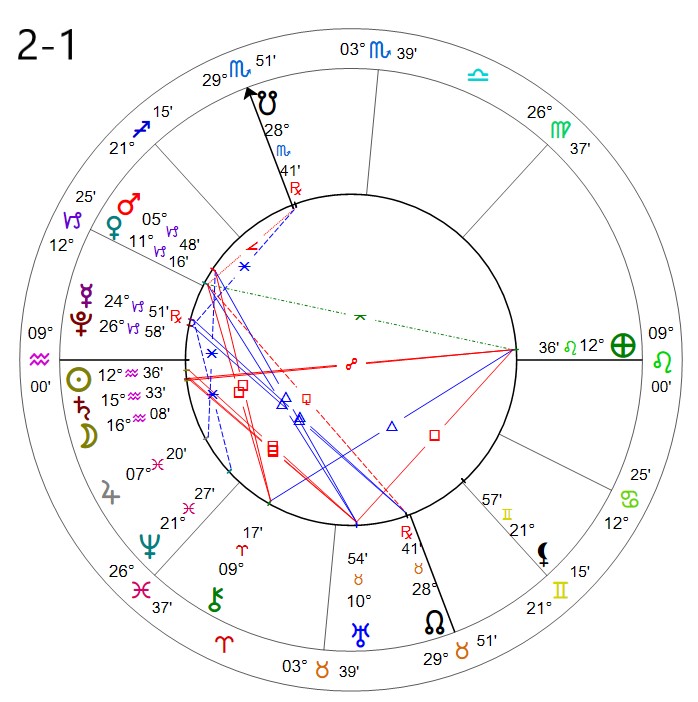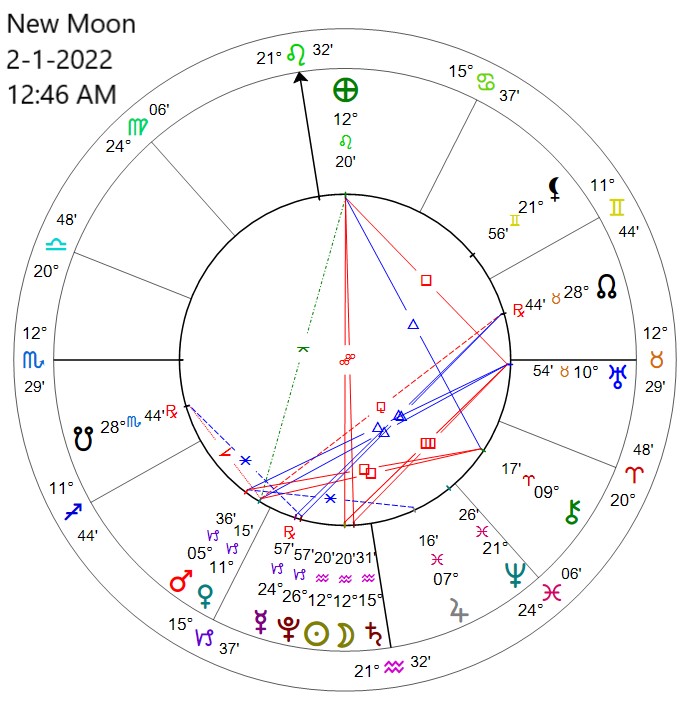Tuesday February 1, 2022

– New Moon Phase – begin, initiate, wish, project, set an intention
– Moon in Aquarius –
– Mercury Retrograde 1/14 – 2/3 11 AQUARIUS: during a silent hour, a man receives a new inspiration which may change his life
– Retrograde Planets – Mercury
– Best Days (from the Farmer’s Almanac) – February 1st – Potty Train, Wean, Paint, Cut Firewood, Kill Plant Pests, Dig Holes, Mow to Increase Growth, Castrate Farm Animals, Host a Party
– Planting Calendar (from the Farmer’s Almanac) – February 1st – Barren day. Fine for clearing, plowing, fertilizing, and killing plant pests.
– Aspect of the Aeon Sophia: (Wisdom): Kali, The Goddess of Beginnings and Endings
– Aspect of the Aeon Thelete: (Will/Desire): Seth– God of the North, God of Enlightenment
– Sabian Symbol for the Solar-Lunar Month – New Moon in Aquarius: “a barometer ” (& “an old sea captain rocking on the porch of his cottage”)
– Sabian Symbol for the Solar-Lunar Year: –“A Woman in pastel colors carrying a heavy and valuable but veiled load”
SUN – 13 AQUARIUS: a barometer
EARTH – 13 LEO: an old sea captain rocking on the porch of his cottage
New Moon in Aquarius

SUN/MOON – 13 AQUARIUS: a barometer
EARTH – 13 LEO: an old sea captain rocking on the porch of his cottage
SATURN – 16 AQUARIUS: a big businessman at his desk
JUPITER – 08 PISCES: a girl blowing a bugle
NEPTUNE – 22 PISCES: a prophet bringing down the new law from Mount Sinai
CHIRON – 10 ARIES: a teacher gives new symbolic forms to traditional images
URANUS – 11 TAURUS: a woman sprinkling flowers
NORTH NODE – 29 TAURUS: two cobblers working at a table
SOUTH NODE -29 SCORPIO: an Indian woman pleading to chief for the lives of her children
BLACK MOON – 21 GEMINI: a tumultuous labor demonstration
MARS – 06 CAPRICORN: ten logs lie under the archway leading to darker woods
VENUS – 12 CAPRICORN: a student of nature lecturing, revealing little-known aspects of life
MERCURY – 25 CAPRICORN: an Oriental rug dealer in store filled with precious ornamental rugs
PLUTO – 27 CAPRICORN: a mountain pilgrimage
CHINESE NEW YEAR – The Year of the Tiger
2022 is a year of the Water Tiger. It starts from February 1st, 2022, and ends on January 21st.
The Tiger is known as the king of all beasts in China. The zodiac sign Tiger is a symbol of strength, exorcising evils, and braveness.
Water Tiger comes from Tiger’s five elements (Gold, Wood, Water, Fire and Earth) . 2022 is the Year of the Water Tiger, which indicates a prosperous year due to the Tiger’s auspicious signs (strength, exorcising evils and braveness).
Lunar New Year begins on the date of the second new Moon after the winter solstice, which always takes place in late December (on our about 12/21). This means that the first day of the Lunar New Year can occur anytime between January 21 and February 20.
from the website “Asia for Educators” http://afe.easia.columbia.edu/special/china_general_lunar.htm
The marking of the passage of time in China is closely linked to the cyclical pattern of agricultural production. The vast majority of the population of this agrarian society has always resided in rural areas and supported itself directly or indirectly by the tilling of the soil. Their lives follow events necessary to sustain life: plowing the fields, sowing seed, nurturing the crops, and gathering the harvest. As such it was necessary to be able to keep track of the optimal times for performing certain tasks. If a peasant waited too long to plant a crop, he might miss the spring rains; if he hesitated to reap his more delicate vegetables, he might lose them to the first frost.
Known as both the agricultural calendar and the old calendar, the lunar calendar is also referred to as the Xia calendar because legend holds that it dates from the time of the Xia dynasty (21st to 16th centuries BCE). No sophisticated astronomical instruments were necessary to observe the regular waxing and waning of the moon, and so it is the earth’s satellite itself that is considered to be the earliest instrument of celestial observation. Peasants could measure time by simply recording the revolutions and phases of the moon. While useful for counting time periods, it wasn’t much help in accurately predicting seasonal changes. The ancients knew that there were roughly 29½ days between new moons and that therefore 12 revolutions of the moon required 354 days. While this was relatively close to the time required for the earth to make one turn around the sun (365¼ days) and thus for the seasons to complete one full cycle, it was a great enough difference to render the lunar calendar impractical for foretelling seasonal changes. The same date on a calendar of 12 lunar months would fall at a different seasonal time each year.
To account for the extra half day in each lunar revolution, the calendar makers assigned 29 days to half the months and 30 to the others. To reconcile the differences in lunar measurement with the solar year of four full seasons, one intercalary, or extra month was added every two or three years. The result was a luni-solar calendar that, in each 19-year period, has 12 years with 12 months and seven with 13 months. Oracle bone inscriptions of the Shang dynasty (ca. 1600 to ca.1050 BCE) offer evidence that the intercalary month had already been adopted by that time.
